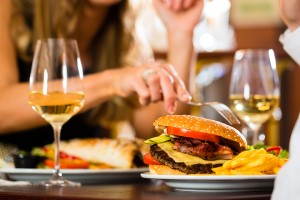Recently I saw a flyer of a fast food chain restaurant entitled “Food Fact”. Interestingly you get the contents of a list of bakery items, warm breakfast items, burgers, sandwiches and wraps for lunch as well as yogurt parfaits and fruit cups.
I have to commend the restaurant chain to attempt to educate their customers by itemizing each item. They have listed the serving size broken down into calories, total fat, saturated fat, trans fat, cholesterol, sugar, protein, dietary fiber, vitamin C, A, calcium and iron.
Based on my dietary habits I need to check this list.
No trans fat
Years ago I have given up on trans fats because trans fat contain free radicals that accelerate hardening of the arteritis. Granted , the percentage is low, but 20% come from natural meats and 80% from processed foods. It is the 80% from processed foods that I avoid. Here is another review that explain trans fats in more detail. This eliminates the baked sweet pieces like croissants, cookies, raisin bran muffins, oat fudge bars and even spinach feta wraps.
Total fat
Now we come to total fat. The content list shows me that calories in total and fat content in total are closely related. But you reach the peak when you swallowed a sausage, egg and cheddar breakfast sandwich. This alone accounts for 500 calories. This is also high in cholesterol and high in sodium, so not really on my list of desirable foods.
Sodium content
I am now getting concerned about my blood pressure as I follow the sodium content. Who would have thought that a spinach feta wrap has more than 800mg of sodium? And ham and a Swiss Panini have more than 1500 mg of sodium? Literally 50% of the food list would not be on my menu, if I want to limit my sodium intake to 400mg or less per helping. Especially the sandwiches are out!
Hidden sugar
So, now I am looking at a yoghurt for a light snack, but suddenly the sugar column has sprung up from 1-2 mg of sugar content in simple sandwiches to 37 to 55 mg of sugar for honey creek yoghurt parfait to strawberry blueberry parfait. It is not the yoghurt, it’s not the fruit, it is extra sugar, honey or high-fructose corn syrup mixed in here. This is definitely not what I am going to choose.
Refined carbs
Although the carbs by weight do not appear too high on the list, it is the total of sugar and carbs and the fat that has been added, which add up very quickly to hefty calorie sums in all of the foods. I am shaking my head and I absolutely cannot find anything that is healthy and would merit being eaten by me.
Missing greens
I am missing vegetables and salads. The only thing I see that I can eat is their classic oatmeal, which has 160 calories with a nut medley topping. I may add a decaf-coffee sweetened with my own stevia that I brought along and some cream (because that’s how I still like it having been raised in Germany).
Homemade food
Then I rush to the health food store and to the grocery store and load up on organic foods, meat, lettuce, broccoli, peppers, spinach, organic olive oil and balsamic vinegar. And, yes, a tub of plain goat yoghurt. Organic walnut halves are also on the list (quite expensive, I must say).
I suddenly realize that now I have all of the ingredients to never enter a restaurant again. I can prepare my own food and I can do it the way I want it, not how the food industry wants me to eat it.
If I ate the food industry’s way, the salt content would send my blood pressure through the roof and I would get hardening of the arteries within the shortest time (from refined sugar, starchy foods and trans fats).
I find the taste of home cooked meals superb. All of the flavors are there. Of course, I do not mind spending the extra money on the organic food, because the tastes are the way my grandmother’s food used to taste. I rarely add salt and my blood pressure is 105/65, so something must be going right.
I am thinking what would happen, if more people would do what I do: avoid restaurants, especially fast food places, pack your own lunch box with an organic salad and enjoy dinner at home. It can be simple, tasty, healthy, and economical. Nobody needs to be an accomplished chef to do that. Would there be pressure on the food industry to open up organic restaurants and offer alternatives to those who want to enjoy healthy, tasty foods ? Or are the fast food places here to stay forever and ever?
Conclusion
I thought I go with you today to one of those fast food places that actually list their food content. Listing it does not really help when the whole list consists almost exclusively of foods that are having serious drawbacks, be it in the addition of too much sodium, fats, sugar or refined carbohydrates.
You do not want to get accelerated hardening of your arteries from too much fat, trans fat, sugar and starchy foods. You don’t want to get high blood pressure from too much salt day after day. You may want to rethink that processed foods are really lacking the nutrition that your body needs to function well and healthy. A lot of them are best to be thrown out. You need fresh, organic vegetables and lettuce, spinach, Swiss chard etc. Maybe you want a vegetable omelet for breakfast with egg white, spinach, peppers and Swiss chard? Take charge of your own life. Look after your own affairs. This includes what you do in your kitchen and what foods you consume.
More information on:
1. High blood pressure: http://nethealthbook.com/cardiovascular-disease/high-blood-pressure-hypertension/
2. Cardiovascular disease: http://nethealthbook.com/cardiovascular-disease/
Last edited Nov. 8, 2014






